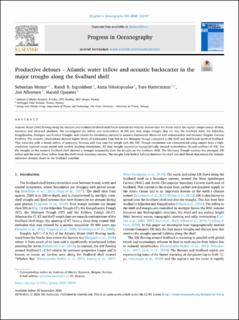| dc.contributor.author | Menze, Sebastian | |
| dc.contributor.author | Ingvaldsen, Randi Brunvær | |
| dc.contributor.author | Nikolopoulos, Anna | |
| dc.contributor.author | Hattermann, Tore | |
| dc.contributor.author | Albretsen, Jon | |
| dc.contributor.author | Gjøsæter, Harald | |
| dc.date.accessioned | 2020-12-15T13:32:36Z | |
| dc.date.available | 2020-12-15T13:32:36Z | |
| dc.date.created | 2020-10-27T07:59:07Z | |
| dc.date.issued | 2020 | |
| dc.identifier.citation | Progress in Oceanography. 2020, 188 . | en_US |
| dc.identifier.issn | 0079-6611 | |
| dc.identifier.uri | https://hdl.handle.net/11250/2719589 | |
| dc.description.abstract | Atlantic Water (AW) flowing along the western and northern Svalbard shelf-break extends the Atlantic domain into the Arctic and is the region’s major source of heat, nutrients and advected plankton. We investigated the inflow and recirculation of AW into four major troughs that cut into the Svalbard shelf, the Isfjorden, Kongsfjorden, Hinlopen and Kvitøya Troughs, and related the circulation patterns to acoustic backscatter observed with echosounders and Acoustic Doppler Current Profilers. The acoustic observations showed higher levels of backscatter from fish in the Hinlopen Trough compared to the shelf and shelf-break north of Svalbard. This coincides with a steady inflow of nutrients, biomass and heat into the trough with the AW. Trough circulation was characterized using output from a high-resolution regional ocean model and particle tracking simulations. All four troughs experience topographically steered recirculation (in-and-outflow) of AW, but the troughs on the western Svalbard shelf showed a stronger seasonality than the troughs on the northern shelf. The Hinlopen Trough receives the strongest AW inflow and the most direct inflow from the shelf-break boundary current. The troughs form hybrid habitats between the shelf and shelf-break that extend the Atlantic advective domain closer to the Svalbard coastline. | en_US |
| dc.language.iso | eng | en_US |
| dc.title | Productive detours – Atlantic water inflow and acoustic backscatter in the major troughs along the Svalbard shelf | en_US |
| dc.type | Peer reviewed | en_US |
| dc.type | Journal article | en_US |
| dc.description.version | publishedVersion | en_US |
| dc.source.pagenumber | 14 | en_US |
| dc.source.volume | 188 | en_US |
| dc.source.journal | Progress in Oceanography | en_US |
| dc.identifier.doi | 10.1016/j.pocean.2020.102447 | |
| dc.identifier.cristin | 1842484 | |
| dc.relation.project | Norges forskningsråd: 228896 | en_US |
| cristin.ispublished | true | |
| cristin.fulltext | original | |
| cristin.qualitycode | 1 | |
